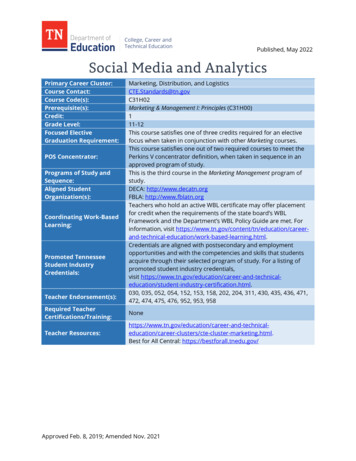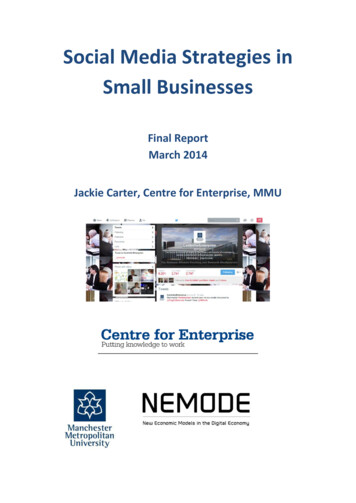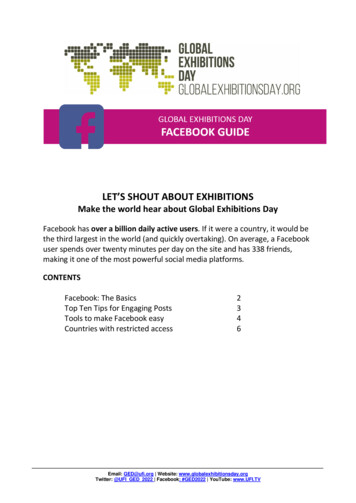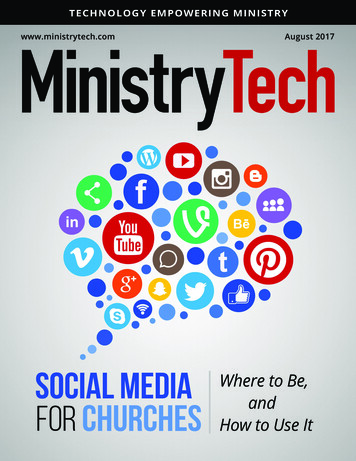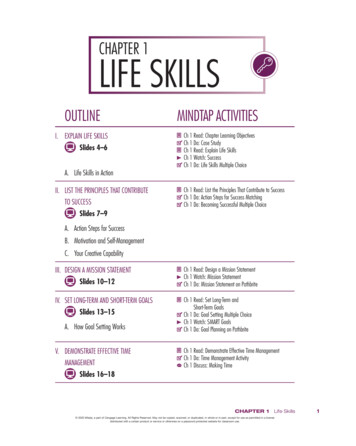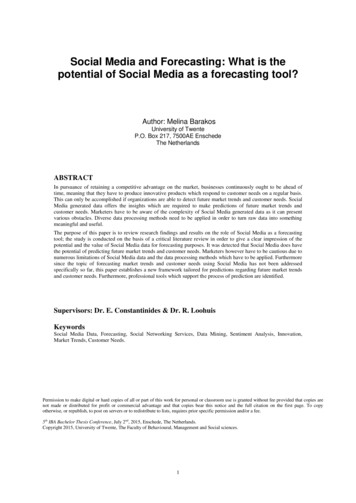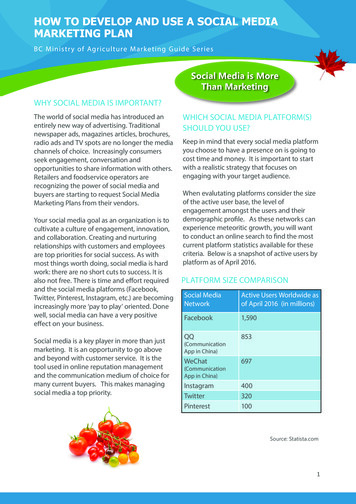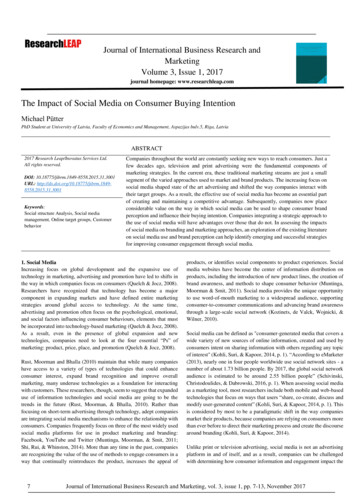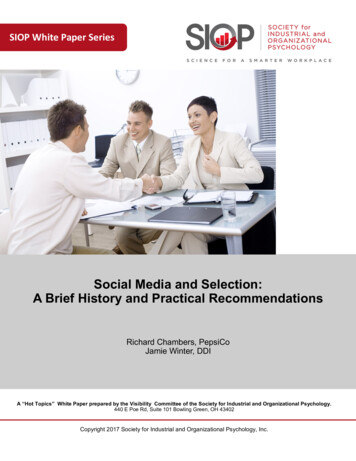
Transcription
SIOP White Paper SeriesSocial Media and Selection:A Brief History and Practical RecommendationsRichard Chambers, PepsiCoJamie Winter, DDIA “Hot Topics” White Paper prepared by the Visibility Committee of the Society for Industrial and Organizational Psychology.440 E Poe Rd, Suite 101 Bowling Green, OH 43402Copyright 2017 Society for Industrial and Organizational Psychology, Inc.
SIOP White Paper SeriesTable of ContentsAuthors . 3Abstract. 4Introduction . 4Background. 4Implications for Practice . 6Next Steps . 8References . 112
SIOP White Paper SeriesAuthorsRichard ChambersPepsiCoRichard Chambers has been with PepsiCo since 2014. Richard iscurrently a team member on the Enterprise OD Talent ManagementCenter of Excellence, and is responsible for the research, design,and deployment of global employee insights. Richard has also assumed Global Organization Management and Development roleswithin PepsiCo as well as supported sectors such as Frito-Lay wherehe gained experience in surveys, assessment, workforce planning,and analytics. Prior to PepsiCo, Richard worked in talent management, assessment,and selection as an external consultant. Richard earned his Ph.D. degree in Industrial-Organizational Psychology from Louisiana Tech University.Jamie WinterDDIJamie Winter joined DDI in 1996 and is currently a Strategic AccountManager in their US Operations Group based in Grand Rapids, MI.Jamie has 20 years of experience helping organizations across avariety of industries in the private and public sectors develop and implement a variety of talent management initiatives, including performance management, re-engineering/downsizing, success profiling/job analyses, selection and promotion systems, leadership development, and succession management. Jamie has also conducted research, written blogs, and participated in several panels on the topic of social mediaand selection. Jamie graduated with honors with a major in Psychology and a minor inBusiness from the University of Nebraska-Lincoln, and earned his M.A. in Industrialand Organizational Psychology from the University of Akron.3
SIOP White Paper SeriesAbstractIn the past 6 years, membership on social media sites has exploded.Over this same time period, organizations and their staffing/recruiting functions quickly embraced this new technology and foundsocial media to be a great tool to source candidates for open positions and justify selection and hiring decisions. In this “HotTopics” paper, a part of the SIOP White Paper Series, we explorethis rapidly growing trend.IntroductionIn 2010, there were only about 350,000 users on Facebook, 90,000 users on Twitter,and a paltry 50,000 members on LinkedIn (Browser Media, 2011). In the past 6 years,membership on these social media sites has exploded. Current statistics show thereare over 1.7 billion Facebook users, 313 million active monthly Twitter users, and 450million members on LinkedIn (Statistica, 2016). During this time, many other socialmedia sites have come on the scene such as Glassdoor, Instagram, Snap Chat, Tumbler, WeChat, and WhatsApp. Needless to say, social media is here to stay. Over thissame time period, organizations and their staffing/recruiting functions quickly embraced this new technology and found social media to be a great tool to source candidates for open positions and justify selection and hiring decisions. In this “Hot Topics”paper, a part of the SIOP White Paper Series, we explore this rapidly growing trend.BackgroundThere are a few key points to make when it comes to discussing the use of social media to source candidates. First, things are changing to a candidate-driven market asthe economy continues to recover and grow, making it more difficult for organizationsto find qualified applicants. A recent survey of recruiters by MRI found that the mostsignificant barrier to increasing headcount was a shortage of qualified applicants(King, 2015). Second, in order to compete for difficult to find qualified candidates, organizations have turned to social media. A recent Jobvite survey found that 92% ofrecruiters used social media to source their candidates (Jobvite Social Recruiting Survey, 2015). After employee referrals (78%), recruiters reported finding their best candidates through social and professional networks (56%). If organizations are not smartabout the use of social media to source candidates, they will be bound to lose out onattracting the right candidates to fill positions.4
SIOP White Paper SeriesOnce candidates have been identified, social media profiles can be leveraged toscreen out candidates. Career Builder conducted one of the first studies to look atthe use of social media to screen candidates in 2009. In this study, they found thatonly 16% of the 2,600 hiring managers they surveyed were using social media profiles to screen out candidates. The growth of social media in the past seven yearshas made it more likely that candidates will have social media profiles and that recruiters and hiring managers will use that information to screen out candidates theyfeel are not qualified for given roles. For instance, in a 2015 Career Builder study,they found that about half of the 2,175 hiring managers surveyed used informationthey found on social media to screen out potential candidates. What is particularlytroubling with this finding (and several others like it) is the rationale they shared tomake those screening decisions. Of the group that used social media to screen candidates, 46% said they screened out candidates due to provocative or inappropriateAbout half of the hiringmanagers surveyed usedinformation they found onsocial media to screen outpotential candidates.photographs; 30% mentioned poor communication skills; and 14% mentioned thecandidates’ use of an emoticon. A more recent survey by The Society for Human Resource Management reported similar results: about 4 out of 10 employers are usingsocial media to screen applicants with similar screening decisions (SHRM, 2016).As one might expect with the explosion of social media, particularly for sourcing andscreening candidates, researchers have started to look into the practical value of thisnew tool. Much of the initial research focused on which social media sites were producing the most application views, candidate applications, and ultimately new hires(Bullhorn, 2012). In this study, LinkedIn generated significantly more applicationviews, candidate applications, and new hires than both Facebook and Twitter combined. Other researchers have started to look at the reliability and validity of socialmedia profiles for use as a selection tool (Davison, Maraist, Hamilton, & Bing, 2012;Guilfoyle, Bergman, Hartwell, & Powers, 2016; Kluemper, Rosen, & Mossholer,2012; Sinar & Winter, 2012). Initial findings have shown that data from social media5
SIOP White Paper Seriessites is both reliable and has significant correlations with various ratings of job performance (i.e., Davison, Bing, Kluemper, & Roth, 2016; Kluemper, Rosen & Mossholder, 2012; Kluemper & Rosen, 2009; Peluchette & Karl, 2010; Sinar & Winter, 2012),but there have been mixed results regarding whether the use of social media provides predictive ability beyond more traditional screening tools (i.e., incremental validity) such as personality tests, situational judgment items, and biodata (Brown &Bergman, 2015; Rupayana, Puchalski, & Hedrick, 2015; Sinar & Winter, 2012; VanIddekinge, Lanivich, Roth, & Junco, in press). In other words, the extent to which social media is a reliable and accurate indicator of later success on the job remains unclear. The bottom line is there can be both value and risks for organizations usingsocial media to source and screen candidates. The value or risks created by thesepractices will depend on how processes involving social media are applied and managed just like any other selection process.Implications for PracticeThe use of social media to source and screen candidates is fairly new. Research onthis topic is still in its early stages (Roth, Bobko, Van Iddekinge & Thatcher, 2016).Further, our legal system is in the process of playing catch-up evaluating the implications of these practices. This means that despite the potential benefits that socialmedia may be able to provide, there are also legal ramifications that should be understood and accounted for when deciding if and how to use social media during theselection process. SHRM (2015) echoes this cautionary tale warning that using social media to screen candidates is still risky, citing the increased potential for discrimination, violation of consent and privacy, and legal as well as moral issues. Moreover, a few of the primary concerns with using social media in selection decisions arethe increased potential of using information that is not job-related and using information inconsistently across applicants. The importance of these concerns is furtherrealized when coupled with findings from a recent analysis of EEOC/OFCCP rulings,which found that the most common legal challenges to selection systems were se-The bottom line is there can be both value and risks fororganizations using social media to source and screencandidates. The value or risks created by these practices willdepend on how processes involving social media are appliedand managed just like any other selection process6
SIOP White Paper Serieslection instruments not being job-related, lack of documentation, and the use of an inconsistent process(Williams, Schaffer, & Ellis, 2013).The use of social media throughout the selection processmay also result in poor utility and create additional opportunities for discrimination (i.e., disparate treatment anddisparate impact). Poor utility refers to the fact that unless the use of social media is a reliable and valid selection process, its use may not help improve the selectionsystem and may result in additional risk for legal challenges. Whether social media screening increases thequality of a selection system will depend on whether thescreening criteria are job-relevant and consistently applied. If these two criteria are met, then adding social media screening to the process may improve the selectionprocess (e.g., make it more valid or even more efficient).However, if these criteria are not met, then adding socialmedia screening may decrease the quality of the selection process and open the employer up to additional legalrisks.Whether social mediascreening increasesthe quality of a selection system will dependon whether the screening criteria are jobrelevant and consistently applied.Disparate treatment means treating certain applicants differently, because they belong to a specific protectedgroup (e.g., race, color, religion, national origin, sex, pregnancy, age 40 and over, disability) and is illegal. For example, a hiring manager’s search of Facebook can easilyreveal information about an applicant’s protected classstatus. In turn, proving that such information was not usedduring the decision making process can be extremely difficult and creates additional legal risks for organizations(SHRM, 2015). Disparate impact, as it relates to the useof social media in the selection process, could result fromusing social media profiles as part of a selection processin such a way that appears neutral, but disproportionatelyresults in the unintentional selection of only a specificgroup of protected class applicants. This could occur if aspecific group of applicants that are part of a protectedclass are more likely to have or not have a social mediaprofile or information on their social media profiles thatwould significantly increase their chances of being removed from the selection process. In both cases, organizations may open themselves up to legal scrutiny on thebasis of selection practices that are potentially discriminating against certainindividuals.7
SIOP White Paper SeriesIn addition to increased risks of disparate treatment and disparate impact, there are alsomany additional laws that can come into play; and our legal system is regularly generatingnew case law that will continue to shape the way in which it is legal to use social mediaduring the selection process. A few specific laws that may not immediately appear to berelated, but that should be considered, include the National Labor Relations Act (NLRA),Fair Credit Reporting Act, as well as various international data privacy laws.Although these last few paragraphs painta gloomy picture for the use of social media during selection, the use of socialmedia may also have a bright side. WhileResearch has shown thatit has been acknowledged that the use ofjob-relevant personalitysocial media sites may increase the riskof gathering information that is not jobtraits can be measuredrelated, sites such as LinkedIn and Faceusing social media andbook may still provide unique opportunities to assess information that is jobcan be tied back to jobrelated. For instance, sites such asperformance for variousLinkedIn provide an opportunity to learnabout an applicant’s job-related skills andtypes of work.previous work experience, while othersites such as Facebook have the potential to provide information about an applicant’s personality and potential fit for anorganization. Research has shown thatjob-relevant personality traits can be measured using social media and can be tied backto job performance for various types of work such as clerical, customer service, and salesjobs (Kluemper et al., 2012). Other research has offered similar insights and shown thatsocial media can be used to measure information that differentiates between high and lowacademic performers (Kluemper & Rosen, 2009). It is important to acknowledge that thisspecific area of research is still in its infancy and more research is needed in the future.Next StepsTo justify integrating the use of social media profiles into employee selection processes, itis recommended that organizations leverage best practices for selection and follow recommendations based on legal precedents. One of the first considerations is to ensure thatorganizations have a clear set of criteria based on job analysis that define what it takes tobe successful on the job. Once organizations have defined what it takes to be successfulon the job, basic selection system design principles suggest that they should then selecttools and design processes based on considerations such as reliability and validity, fairness to all candidates, candidate experience, process efficiency, and cost. These samecriteria should be applied when organizations consider using social media in selectionprocesses: when deciding whether or not to use information from social media, when8
SIOP White Paper Seriesconsidering whether the portions of profiles being reviewed are job-related, or when considering whether theportions of profiles being reviewed are used in a consistent manner across candidates.Organizations should also consider the potential reactions applicants may have about an organization viewingprivate forms of social media. LinkedIn is a professionalform of social media and it may be safe to assume thatapplicants would understand if an organization reviewsthis type of profile as part of a selection process. Thesame may not be true of other forms of social media,which are typically considered to be more personal. Highly qualified applicants may find it inappropriate for organizations to view private forms of social media such as Facebook and as a result may choose to self-select out of aselection process. In turn, organizations should considerthe potential impact of missing out on qualified applicantsthat may self-select out if organizations decide to incorporate social media profiles as part of their selection process.One of the first considerations is to ensurethat organizations havea clear set of criteriabased on job analysisTo ensure successful implementation of social media, thefollowing steps are encouraged: Develop a social media policy for your organization that details exactly how social media is allowed to be used during the selection process: besure to work closely with your legal department to ensure that the policy reflects current local, state, andfederal law, and even international law. Once the policy is developed, it is important to make sure that thereare governance processes in place to implement andenforce the social media policy consistently across theorganization. Create and document a specific process thatincludes predefined criteria based on job analysis for collecting only jobrelated information from applicant social media profiles. This process shouldbe applicable to all potential applicants and should include a detailed process forremoving an applicant from the selection process based on job-related criteria. Anytime an applicant is removed from the selection process, a job-related reason alsoneeds to be documented.9
SIOP White Paper Series Use a third party or employees that are not involved in the decision making process to provide standardized ratings based on applicant social media profiles.Alternatively, it may be possible to obtain from a third party provider “big data” that includes job-relevant criteria from applicant social media profiles. This will help preventdecision makers from unintentionally learning of an applicant’s protected class status. Provide all raters of social media profiles with standardized instructions andtraining on how to make ratings. This will help ensure all social media profileratings are collected consistently across applicants and that only job-related information is being collected from social media profiles. Prior to collecting any ratings from social media profiles, ensure that applicantshave been notified. This notification process should be done in writing.10
SIOP White Paper SeriesReferencesBrowser Media (2011, March 31). 2011 statistics show a huge growth in social media[Blog post]. Retrieved from l-media-statistics-show-huge-growth/.Brown, C., & Bergman, S. M. (2015, October). Predicting attributes of an individual: Avalidation of text analytics. Poster session presented at the annual River CitiesIndustrial-Organizational Psychology Conference, Chattanooga, TN.Bullhorn, 2012. The 2012 social recruiting activity report: The definitive look at socialmedia usage in recruiting [Research summary]. Retrieved from lt/files/BullhornReach 2012ActivityReport.pdf.Career Builder, 2009. Forty-five percent of employers use social networking sites to research job candidates, CareerBuilder survey finds [Blog post]. Retrieved ssreleasesdetail.aspx?id pr519&sd 8/19/2009&ed 12/31/2009.Career Builder, 2015. 35 percent of employers less likely to interview applicants theycan’t find online, according to annual CareerBuilder social media recruitmentSurvey [Blog post]. Retrieved from leasesdetail.aspx?sd 5%2F14%2F2015&id pr893&ed 12%2F31%2F2015.Davison, H. K., Bing, M.H., Kluemper, D.H., & Roth, P. L. (2016). Social media as apersonnel selection and hiring resource: Reservations and recommendations. In.R.N. Landers & G.B. Schmidt (Eds.), Using Social Media in Employee Selection:Theory, Practice, and Future Research. New York: Springer.Davison, K. H., Maraist, C. C., Hamilton, R. H., & Bing, M. N. (2012). To screen or notto screen? Using the internet for selection decisions. Employee Responsibilitiesand Rights Journal, 24, 1-21.11
SIOP White Paper SeriesGuilfoyle, S., Bergman, S. M., Hartwell, C., & Powers, J. (2016). Social media, big data,and employment decisions: Mo’ data, mo’ problems? In. R.N. Landers & G.B.Schmidt (Eds.), Using Social Media in Employee Selection: Theory, Practice, andFuture Research. New York: Springer.Jobvite (2015). 2015 Recruiter Nation. Retrieved from: http://www.jobvite.com/.Kluemper, D. H., & Rosen, P. A. (2009). Future employment selection methods: Evaluating social networking web sites. Journal of Managerial Psychology, 24, 567-580.Kluemper, D. H., Rosen, P. A., & Mossholder, K. W. (2012). Social networking websites,personality ratings, and the organizational context: More than meets the eye? Journal of Applied Social Psychology, 42, 1143-1172.King, N. (2015, December). Recruiter Sentiment Study 2015 2nd Half. MRI Network. Retrieved from http://www.mrinetwork.com/media/1036/2015 recruiter sentiment study 2nd half.pdf.Peluchette, J., & Karl, K. (2010). Examining students’ intended image on Facebook:“What were they thinking?!”. Journal of Education for Business, 85, 30-37.Roth, P. L., Bobko, P., Van Iddekinge, C. H., & Thatcher, J. B. (2016). Social media inemployee-selection-related decisions: A research agenda for uncharted territory.Journal of Management, 42, 269-298.Rupayana, D., Puchalski, L., & Hedrick, C. A. (2015, April). Qualitative vs. quantitative data for predicting outcome: Focus on conscientiousness. In D. Rupayana (Chair),Beyond Mining: Harnessing the Power of Text Data. Symposium session conducted at the annual Society for Industrial and Organizational Psychology Conference,Philadelphia, PA.Society for Human Resource Management [SHRM]. (2015). Know Before You Hire: 2015Employment Screening Trends. Retrieved from http://www.shrm.org/.12
SIOP White Paper SeriesSociety for Human Resource Management [SHRM] (2016). SHRM Survey Findings: Using Social Media for Talent Acquisition – Recruitment and Screening [PowerPointslides]. Retrieved from http://www.shrm.org.Sinar, E. F., & Winter, J. 2012. Social media and selection: How on-line information helpsand hurts your hiring process. DDI Directions, 1-9. http://www.imakenews.com/ddi/e article002559717.cfm?x b11,0Statista (2016, September 15). Statistics and facts about social media. Retrieved September 15, 2016 from http://www.statista.com.Van Iddekinge, C. H., Lanivich, S. E., Roth, P. L., & Junco, E. (in press). Social media forselection? Validity and adverse impact potential of a Facebook-based assessment.Journal of Management.Williams, K. Z., Schaffer, M., M., & Ellis, L. E. (2013). Legal risk in selection: An analysisof processes and tools. Journal of Business and Psychology.13
ganizations have turned to social media. A recent Jobvite survey found that 92% of recruiters used social media to source their candidates (Jobvite Social Recruiting Sur-vey, 2015). After employee referrals (78%), recruiters reported finding their best candi-dates through social and professional networks (56%). If organizations are not smart


